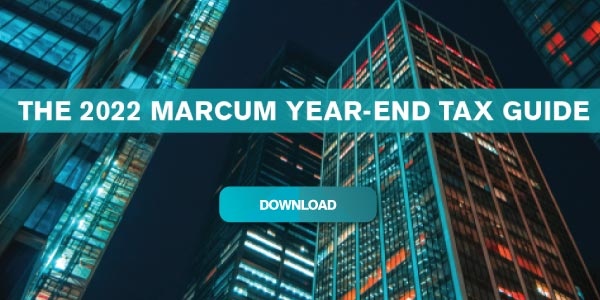State Corporate Income Taxation: Trends in Combined Reporting
A majority of states that impose a corporate income tax have adopted the use of mandatory worldwide, or water’s-edge, combined reporting methods for unitary businesses. At the same time, historically separate-filing states are seeking to adopt combined reporting tax regimes for corporate taxpayers. Even states that presently utilize combined reporting, typically on a default water’s-edge basis, are trending towards worldwide combined reporting, which has the tendency to broaden the income base subject to state income taxation.
The gradual shift from a separate to a combined reporting environment over time has been undertaken by states as a means of increasing the tax base to generate additional sources of revenue, and to neutralize the effects of tax planning strategies, which pit combined and separate reporting states against each other.
Unitary Group Opportunities
While combined reporting often limits potential opportunities for impacted businesses through the imposition of mandatory rules under separate reporting regimes, several opportunities may be available, including defining the unitary group subject to combination, as well as apportionment planning in the proper calculation of the sales factor.
In most combined reporting jurisdictions, a corporation will be includible in a combined report if it is part of a commonly controlled group, is conducting a unitary business with one or more entities in the group, and is not specifically excluded. Consistent with a series of judicial decisions, states only have the power to mandate a combination of corporations that are part of a unitary group.
In Butler Brothers v. McColgan,1 the U.S. Supreme Court (Court) developed the three unities test for defining the unitary group, consisting of:
- Unity of Ownership – generally defined as greater than 50% ownership in the outstanding shares of voting stock of another corporation.
- Unity of Operation – characterized by a centralized executive structure with central purchasing, advertising, accounting and management, and
- Unity of Use – reflected by an executive authority with control over major policy matters and activities of the business organization, as well as a general system of operation.
Generally, an organization must meet all three unity tests to be considered part of the unitary group. In addition and complementary to the three unities test, the Court has also looked to other factors, which support the concept of a mutually interdependent relationship among commonly owned or commonly controlled entities.
In Edison California Stores v. McColgan,2 the Court developed the contribution or dependency test, which supports the finding of a unitary relationship where operations of a portion of a business performed within the state depend on or contribute to the operations of the business outside the state.
The Court, in relatively more modern times, continued to broaden the unitary business concept in Mobil Oil Corporation, where the Court upheld applications of the unitary business principle as justification for inclusion of dividend income from foreign affiliates in the apportionable tax base.3 The prevailing test of the unitary business concept articulated by the Court in Mobil Oil characterized a unitary business as one having significant flows of value evidenced by three factors: (a) functional integration, (b) centralization of management, and (c) economies of scale.4
Each of the factors of a unitary business focus on the relationship between affiliated entities from different facets of a business’s operations.
Functional Integration
The functional integration test looks to shared functions and refers to transfers between, or pooling among, business entities that significantly affect the operation of the business activities.5 Generally, functional integration includes, but is not limited to, transfers or pooling with respect to the business’s products or services, technical information, marketing information, distribution systems, purchasing, and intangibles. Common examples of business operations that support a finding of functional integration include, but are not limited to:
- Sales, exchanges, or transfers of products, services, and/or intangibles between business activities;
- Sharing of common marketing features among businesses, especially when such marketing results in significant mutual advantage. Common marketing may be deemed to exist when a substantial portion of the business’s products or services are sold to a common customer, when entities use a common trade name, or when entities seek to identify themselves to customers as members of the same enterprise;
- Transfers or pooling of technical information or intellectual property (i.e., patents, copyrights, trademarks, know-how, etc.), when the transfer of such intellectual property is significant to the business’s operations;
- Common purchasing of substantial quantities of products, services, or intangibles from the same source by the entities, particularly where the purchasing results in significant cost saving or where the products, services, or intangibles are not readily available from other sources and are significant to each entity’s operations or sales; and
- Significant common or intercompany financing, including the guarantee by, or the pledging of the credit of, one or more entities for the benefit of another entity or entities, if the financing activity serves an operational purpose of both borrower and lender.6
Centralization of Management
The centralized management test focuses on not the ability to control but the actual amount of common control exercised between business segments. Centralization of management exists when directors, officers, and/or other management employees jointly participate in the management decisions that affect the respective business activities and that may also benefit the entire economic enterprise. Centralization of management may exist even when day-to-day management responsibility and accountability have been decentralized, so long as the management has an ongoing operational role with respect to the business activities. An operational role can be effectuated through mandates, consensus-building, or an overall operational strategy of the business, or any other mechanism that establishes joint management.
Economies of Scale
The economies of scale test focuses on whether there is any income earned as a result of shared functions, activities, or operations. Economies of scale refer to a relation among and between business activities resulting in a significant decrease in the average per-unit cost of operational or administrative functions due to the increase in operational size. Economies of scale may result from the inherent cost savings that arise from the presence of functional integration or centralization of management. The relevant query, thus, is whether the business segments are more profitable when operated together than they would be if each operated independently.
In F.W. Woolworth, the Court indicated that the factors evidencing economies of scale were:
- Centralized management;
- Integration of operations to the extent that the stable operation of one company in the group is important to the ability of another company in the group to operate at full capacity;
- Provision of essential corporate services;
- Centralized purchasing; and
- Uniform credit cards, packaging, or name.7
These factors provide evidence of whether the business activities operate as an integrated whole or exhibit substantial mutual interdependence. In other words, the unitary business principle requires that the out-of-state activities of the purported unitary business be related in some concrete way to the in-state activities, such that the sharing or exchange of value is not capable of precise identification or measurement.8 However, it is important to consider that sharing or exchange of value that characterizes a unitary business relationship generally requires something more than a mere flow of funds arising out of a passive investment, or from the financial strength contributed by a distinct business undertaking that has no operational relationship to the other elements or activities of an entity or commonly controlled group of entities.9
Jurisdictional Inconsistency
Currently, approximately 30 jurisdictions mandate unitary combined reporting for general corporations that are commonly owned or controlled. However, notwithstanding the constitutional tests discussed above, these states adopt varying statutory definitions of “unitary” for purposes of combined reporting. Even in cases where the definitions in different states are consistent, there is significant variation in how the states and/or the courts interpret those definitions from a regulatory and case law perspective. As such, due to the absence of bright-line tests and the application of different standards, a group of corporations may be considered unitary in one state, but not unitary in others; or may be unitary in one year, but not the next.
Generally, a group of corporations that file a federal consolidated return are likely required to file a unitary business group return. However, the composition of the federal consolidated group may not, in many instances, mirror the composition of the unitary business group. Whereas the federal consolidated group’s composition is determined based on ownership,10 the composition of the unitary group is highly dependent on a fact-intensive analysis that examines factors such as functional integration, economies of scale, and centralization of management. As such, it is important to consider the nature of a taxpayer’s business and operations to identify potential tax-saving opportunities by changing the composition of the combined filing group, and the way that income and apportionment factors may be calculated.
Sources
- Butler Brothers v. McColgan, 315 U.S. 501 (1942); See also 17 Cal. 2d 664.
- Edison California Stores v. McColgan, 183 P.2d 16 (1947).
- Mobil Oil Corp. v. Commissioner of Taxes of Vermont, 445 U.S. 425 (1980).
- Ibid.
- Ibid.
- MTC Reg. IV.1.(b)(2).
- F.W. Woolworth Co. v. Dir., Tax’n. Div., 458 U.S. 354 (1982).
- Container Corp. of Am. v. California Franchise Tax Board, 463 U.S. 159 (1983).
- Ibid.
- INTERNAL REVENUE CODE § 1504(a).





















